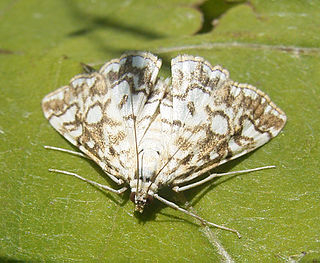Related Research Articles

Pyraustinae is a large subfamily of the lepidopteran family Crambidae, the crambid snout moths. It currently includes over 1,400 species, the majority of them tropical but some found in temperate regions including both North America and Europe.

Nola is a genus of moths described by William Elford Leach in 1815. They are the namesake of the subfamily Nolinae and the family Nolidae. This genus occurs worldwide wherever suitable habitat is present.

Crambinae is a large subfamily of the lepidopteran family Crambidae, the crambid snout moths. It currently includes over 1,800 species worldwide. The larvae are root feeders or stem borers, mostly on grasses. A few species are pests of sod grasses, maize, sugar cane, rice, and other Poaceae. The monophyly of this group is supported by the structure of the tympanal organs and the phallus attached medially to the juxta.

Hampson Archeological Museum State Park is a 5-acre (2.0 ha) Arkansas state park in Mississippi County, Arkansas in the United States. The museum contains a collection of archeological artifacts from the Nodena Site, which is a former Native American village on the Mississippi River between 1400 and 1650. James K. Hampson began excavating the site in the 1920s, a museum was built in 1946 and the Arkansas General Assembly officially accepted the collection of artifacts from the Hampson family on March 30, 1957. The park first opened in 1961 as Hampson Museum State Park and has since been renamed.

Agylla is a genus of moths in the subfamily Arctiinae. The genus was erected by Francis Walker in 1854.

Asura is a genus of moths in the subfamily Arctiinae erected by Francis Walker in 1854.
Chrysochlorosia is a genus of moths in the subfamily Arctiinae. The genus was erected by George Hampson in 1900.
Graphosia is a genus of moths in the family Erebidae. The genus was erected by George Hampson in 1900.
Heliosia is a genus of moths in the family Erebidae erected by George Hampson in 1900.
Lambula is a genus of moths in the family Erebidae. The genus was erected by Francis Walker in 1866.

Macaduma is a genus of moths in the subfamily Arctiinae.

Miltochrista is a genus of moths of the family Erebidae, subfamily Arctiinae. The genus was erected by Jacob Hübner in 1819.

Eoophyla is a genus of moths of the family Crambidae. It was erected by Charles Swinhoe in 1900.
Erupa is a genus of moths of the family Crambidae.

Evergestis is a genus of moths of the family Crambidae described by Jacob Hübner in 1825. A number of species are pests, including the cross-striped cabbageworm, a pest of cole crops such as cabbage.

Loxostege is a genus of moths of the family Crambidae.

Pyrausta is a speciose genus of moths of the family Crambidae. The genus was erected by Franz von Paula Schrank in 1802.

Syllepte is a genus of moths of the family Crambidae.

Acontia is a genus of moths of the family Noctuidae. The genus was named by Ferdinand Ochsenheimer in 1816. Eusceptis, Pseudalypia and Spragueia are sometimes included in the present genus, but here they are tentatively treated as different pending further research. Many species of Tarache were also once placed here.

Acentropinae is a fairly small subfamily of the lepidopteran family Crambidae, the crambid snout moths. Species of this subfamily are exclusively found in wetlands and aquatic habitats.
References
- ↑ Savela, Markku (October 26, 2015). "Chrysochlorosia callistia Hampson, 1900". Lepidoptera and Some Other Life Forms. Retrieved October 17, 2019.
| | This Lithosiini-related article is a stub. You can help Wikipedia by expanding it. |